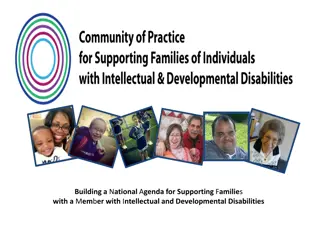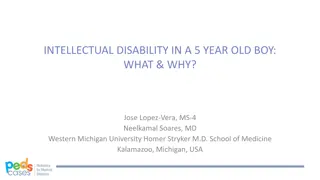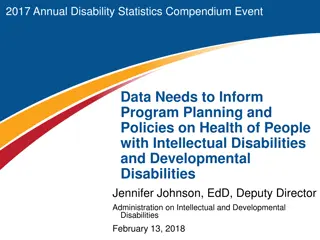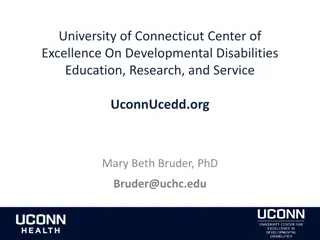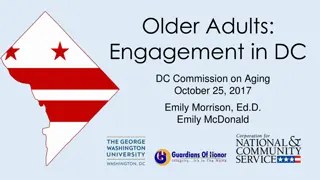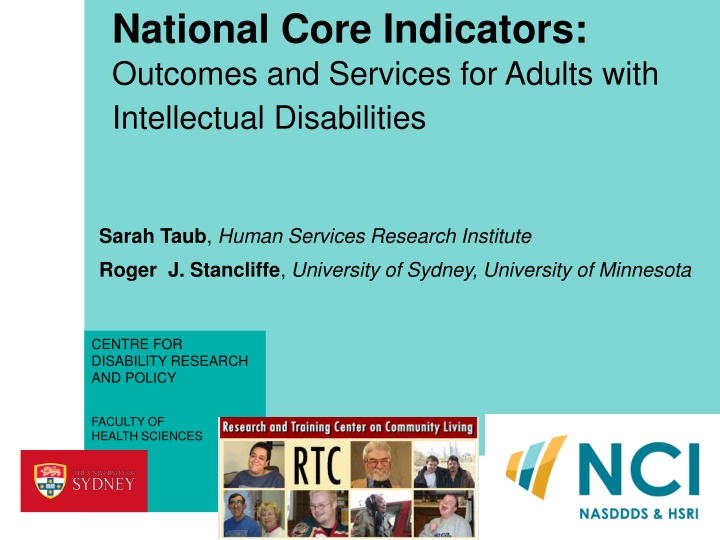
Key Insights into National Core Indicators for Adults with Intellectual Disabilities
Explore the National Core Indicators and their impact on outcomes and services for adults with intellectual disabilities. Learn about the indicator framework, major development activities, adult consumer survey, and funding details for future expansion in this informative study.
Download Presentation

Please find below an Image/Link to download the presentation.
The content on the website is provided AS IS for your information and personal use only. It may not be sold, licensed, or shared on other websites without obtaining consent from the author. If you encounter any issues during the download, it is possible that the publisher has removed the file from their server.
You are allowed to download the files provided on this website for personal or commercial use, subject to the condition that they are used lawfully. All files are the property of their respective owners.
The content on the website is provided AS IS for your information and personal use only. It may not be sold, licensed, or shared on other websites without obtaining consent from the author.
E N D
Presentation Transcript
National Core Indicators: Outcomes and Services for Adults with Intellectual Disabilities Sarah Taub, Human Services Research Institute Roger J. Stancliffe, University of Sydney, University of Minnesota CENTRE FOR DISABILITY RESEARCH AND POLICY FACULTY OF HEALTH SCIENCES
1. National Core Indicators: Development, current use and future expansion
NCI Beginnings Key factors then and now Need to control costs managed care Increased demand for accountability and transparency Changes in how we define quality - Outcomes important to people we serve - Greater emphasis on choice and control - Less focus on physical settings
NCI Beginnings Major development activities Gathering of 15 states in 1997 Six field-test states Facilitated by NASDDDS and HSRI Criteria-based selection of performance indicators - Reflect goals that can be influenced by system - Face validity: relevant to major stakeholders - Directional: represent change over time
NCI Indicator Framework Individual Outcomes Family Indicators Health, Welfare, & Rights System Performance Health & Wellness Information & Planning Service Coordination Employment Safety Access to Supports Choice & Control Incidents & Mortality Respect & Rights Community Connections Staff Turnover Relationships Choice & Control Community Inclusion = Adult Consumer Survey
NCI Adult Consumer Survey Developed with Technical Advisory Group Semi-structured, face-to-face interview No pre-screening of respondents Proxies allowed to answer certain questions High inter-rater reliability Standard training protocols Variety of interviewers used to administer survey
Funding and Future Expansion Primarily funded by public IDD state agencies State participation is voluntary Federal Administration on IDD recently awarded funding for 5-year expansion Provides first-year seed money for 5 states/territories per year
NCI Participating States 2010-2013 NH ME WA MA OR NY WI SD RI MI PA CT NJ OH MD IN IL UT VA DC MO KY CA NC HI SC OK AR AZ NM GA MS AL LA TX FL 2010-11 24 States 2011-12 29 States 2012-13 35 States
Expanded Uses of NCI Original goal: tool for state public managers - National and state-to-state benchmarking - Tracking outcomes over time - System-level quality improvement Collaboration with researchers at U of MN - Large multi-state database with randomly drawn state samples allows for multivariate analyses - Research studies conducted with support from CMS, NIDRR, and AIDD
2. Examples of policy-relevant analyses using NCI data
Choice of Living Arrangements Article 19a of the UN Convention on the Rights of Persons with Disabilities (United Nations, 2006) states: Persons with disabilities have the opportunity to choose their place of residence and where and with whom they live on an equal basis with others and are not obliged to live in a particular living arrangement .
Choice of Living Arrangements POLICY IMPLEMENTATION QUESTION Overall What percentage of adult service users living outside the family home choose where and with whom they live?
Overall NCI Choice Results 2008 6778 adult developmental disabilities service users living in non-family-home service settings in 26 US states
CONCLUSION Most people have no choice of where to live (55%) or whom to live with (59%). Policies endorsing choice of living arrangements are not being implemented satisfactorily.
Choice of Living Arrangements POLICY IMPLEMENTATION QUESTION Does choice of living arrangements vary by residence type and level of disability?
Choosing Whom to Live With(person chose) by Level of Disability and Residence Type 80 60 Institution Group home Apartment Own home Foster care Nursing facility Percentage 40 20 0 Mild Moderate Severe Profound Level of ID
CONCLUSION People with severe/profound intellectual disability had little or no choice of whom to live with, regardless of residence type.
Choosing Whom to Live With(person chose) by Level of Disability and Residence Type 80 Own home 60 Group home Percentage 40 Own home 20 Group home 0 Mild Moderate Severe Profound Level of ID
CONCLUSIONS For people with mild and moderate intellectual disability, choice of living companions varies dramatically by residence type: - own home (73.5% and 57.3% chose) - group home (9.5% and 9.7% chose) These findings support policies promoting individualised settings, such as one s own home or an agency apartment. - These settings do provide substantially more choice about living arrangements, as intended.
Choice of Living Arrangements POLICY IMPLEMENTATION QUESTION Does exercising choice of living arrangements lead to greater wellbeing?
NCI Wellbeing Outcomes Loneliness Feeling happy At Home Feeling afraid at home Feeling afraid in your neighborhood Home staff nice and polite Liking home
Self-Report Data Only Well-being items come from Section I of the NCI Consumer Survey, which may only be completed by interviewing the person receiving services. Due to communication difficulties, some service users could not take part in the interview. Only included participants who were judged by interviewers to have given valid and consistent interview responses. These selection criteria yielded predominantly people with mild or moderate ID.
Loneliness the most widespread problem Percent with positive outcome 100 90.6 88.6 90 83.2 79.7 79.2 80 70 % of total sample 60 53.9 50 40 30 20 10 0 Lonely Scared Home Scared N'hood Well-being outcome Happy Staff Home Like Home
Results Summary Personal characteristics controlled statistically in all comparisons. Item Chose Who to Live with Chose Where to Live Loneliness Feeling happy Afraid at home Afraid in neighbourhood Home staff nice Like home
Conclusion Choosing where to live and whom to live with each are associated with: - multiple wellbeing benefits and - no wellbeing detriments.
Self-Reporting Questions about choice (e.g., where and with whom to live) come from Section II of the NCI Consumer Survey. Section II questions may be completed by interviewing the person or a knowledgeable proxy. Information source for each item is recorded so that it is clear who answered each question. This practice allows for a self-report variable to be included in regression analyses to estimate the effect of self-report vs proxy respondents.
Variability Associated with Self-Reporting Nagelkerke Pseudo R-Square Change by Independent Variable Block 0.35 Residence type Self-reporting Personal characteristics 0.3 0.084 R-Square Change 0.25 0.024 0.2 0.163 0.15 0.202 0.1 0.002 0.05 0.093 0 Where to Live Whom to live with
Conclusion In these analyses self-reporting had a very small (where live) or negligible (whom live with) effect on choice data. In some circumstances it may be acceptable to combine self-report and proxy data,. If data source (self-report/proxy) is entered into the analysis as an independent variable it seems possible to control for and estimate the magnitude of the effect of self-reporting.
Relative Disadvantage POLICY IMPLEMENTATION QUESTION Do people with intellectual disability experience relative disadvantage compared to the general community? - Comparison of outcomes for people with intellectual disability with those experienced by the general community.
Approaches to Comparing Outcomes NCI outcomes vs available population data (e.g., obesity) Comparison Survey general community using NCI (e.g., Kentucky: Sheppard- Jones, Prout, & Kleinert, 2005)
Overall Results: 8,911 adult NCI participants (age 20+) from 20 states Normal weight (BMI < 25) = 37.8% Overweight (25.00 BMI < 30.00) = 28.4% Obese (BMI 30.00 ) = 33.8% 34
How Do These Results Compare to Other American Adults? We compared our data with 2007-08 U.S. general population comparison data (age 20+) from: - Flegal K.M., Carroll, M.D., & Ogden C.L., & Curtin L.R. (2010). Prevalence and trends in obesity among US adults, 1999-2008. JAMA, 303(3), 235-241. Current Issue 35
% Obese(BMI 30.0): Means and 95% CI, US vs NCI 45 40 Percentage of Sample 38.9 35.5 35 33.8 33.6 32.2 30 29.4 25 US all NCI all US men NCI men US women NCI women Group 36
% Obese(BMI 30.0): Means and 95% CI, US vs NCI 45 40 Percentage of Sample 38.9 35.5 35 33.8 33.6 32.2 30 29.4 25 US all NCI all US men NCI men US women NCI women Group 37
Obesity (BMI 30.0) NCI sample vs. U.S. general population - No significant differences in obesity prevalence All people - NCI (33.6%) US (33.8%) Men - NCI (29.4%) US (32.2%) Women - NCI (38.9%) US (35.5%) 38
Policy Conflicts: When Outcomes Reveal a Mixed Pattern of Benefits Obesity and Living Arrangements
% BMI Category by Residence type: All participants 100% 18.6 27.0 31.6 37.7 80% 41.4 42.8 Percentage of Participants 29.0 60% Obese 34.2 31.9 24.3 29.1 26.5 Overweight 40% 42.0 Normal 32.6 31.4 20% 32.0 27.4 26.2 Underweight 10.4 6.6 6.2 4.5 3.4 3.3 Own home 0% Institution Group home Agency apartment Family home Foster home Residence Type 40
% BMI Category by Residence Type: Mild ID only 100% 31.4 36.9 39.1 39.1 80% 45.9 47.4 Percentage of Participants 60% Obese 37.7 25.7 34.9 31.1 Overweight 27 40% 25.3 Normal 20% 31.0 Underweight 27.0 27.4 26.8 25.2 25.3 4.2 3.8 2.4 2.1 1.8 1.3 0% Institution Group home Agency apartment Residence Type Own home Family home Foster home 41
Conclusions We have shown elsewhere that smaller, less regulated settings, such as living in one s own home, are consistently associated with desirable outcomes: - greater wellbeing - greater choice - less loneliness whereas institutions are associated with poorer outcomes. Finding effective ways for people to maintain a healthy weight while living in community settings of their choice presents a challenge for all Americans, both those with and without ID. 42
Overview of NCI Use at State Level Overall quality management - Set priorities for quality improvement - Report evidence to federal funders (CMS Assurances) Report results to stakeholders - Internal state staff - Quality councils/review committees - State legislatures - Providers - Individuals and families receiving services
Examples of State Applications http://www.mass.gov/eohhs/docs/dmr/qa-qina-preventive-screenings.pdf Massachusetts Quality & Risk Management Briefs - Preventive screenings - Rights - Choice
Examples of State Applications http://ahrcnyc.wordpress.com/2012/03/06/health-and-safety-alert-obesity-and-healthy- living/
Examples of State Applications http://test.mr.state.oh.us/health/documents/Alert54-10-10.pdf Highlights areas for improvement based on data trends over time and comparisons with benchmarks (physical exam, dental exam, flu vaccine) Provides recommendations and resources
Examples of State Applications Kentucky Health and Wellness Initiative Quality Improvement Committee (QIC) convened in 2012 Identified health and exercise as target area Provided training to providers, students, faculty, community-based organizations Initiative funded 8 pilot programs promoting inclusive physical fitness and healthy eating activities
Expanding Public Use of NCI Data Evidence-Based Policy Initiative collaboration between NASDDDS and AUCD Research policy and process for requesting data and/or tools - Formal process through NASDDDS Research Committee - Several university researchers and students approved and currently working with data (autism, aging, health) New website with chart generator feature
Chart Generator www.nationalcoreindicators.org

